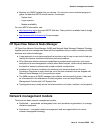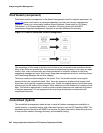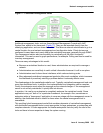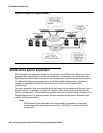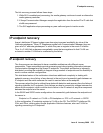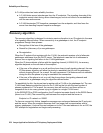
Survivability solutions
Issue 6 January 2008 269
Enterprise survivable servers (ESS)
Note:
Note: See Using the Avaya Enterprise Survivable Servers (ESS), 03-300428, for
additional information about ESS.
The Enterprise Survivable Server (ESS) is a survivability option for S8700-series and S8500/
S8500(B) systems and is available with the Communication Manger release 3.0 and later. ESS
option provides survivability to an Avaya configuration by allowing backup servers to be placed
in various locations in the customer’s network. The backup servers (ESS servers) are given
administered values that are advertised to each IPSI in the configuration. The IPSI places the
ESS server on a priority list based on the administered values. If for any reason, the IPSI can no
longer communicate with the Main server, the IPSI request service from the next highest priority
ESS server on its list. The ESS server accepts the request and assumes control of the IPSI
controlled port network.
The IPSI request for ESS service will happen after an administered “No-Service” timer expires.
The value of the No-service timer determines the amount of time the IPSI will wait to request
service from an ESS server, after losing communication with the Main server or the controlling
ESS server. The value for the No-service timer is administrable from three to 15 minutes.
During No-Service timer interval stable calls remain up in the same state as they were before
the outage occurred. The stable calls do not have access to any features such as hold,
conference, etc. After the No-Service timer expires, shuffled IP to IP calls will stay up, but calls
on DCP or analog phones will terminate.
When service to main is restored, the IPSI(s) will return to the control of the main server in the
manner administered by the customer, which can be either manually or according to a
scheduled time.
In an ESS environment, there is one Main server. The Main server can be a S8500 (B) simplex
server or a pair of S8700-series servers. If the Main server is an S8500 Server, all ESS servers
in the configuration must also be S8500 Servers.
ESS provides a survivability option for port networks of the following platforms:
● S8700-series fiber-PNC with ATM port network connectivity
● S8700-series fiber-PNC with CSS port network connectivity
● S8700-series/S8500(B) IP-PNC systems
● System with combination of fiber-PNC and IP-PNC
Through careful planning and consideration, S8700-series and/or S8500 Servers are placed in
various locations in the customer’s network. Each ESS server is administered on the Main
server. The IPSIs in the configuration contain a list (called a priority list) of ESS servers. The
Main server is always the highest ranking server on an IPSI’s priority list.



